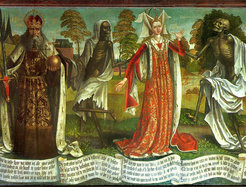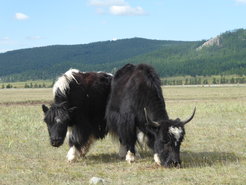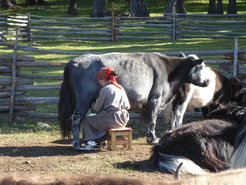Kirsten Bos and Christina Warinner Awarded ERC Starting Grants
The highly competitive grants will allow the recipients to fund research groups on their projects, “Communicable Disease Exchange in the Age of Seafaring” and “Cultures of dairying: gene-culture-microbiome evolution and the ancient invention of dairy foods”.
In the 2018 review cycle, the ERC has awarded highly competitive Starting Grants to two members of the Department of Archaeogenetics, Kirsten Bos and Christina Warinner. The grants will allow the recipients to fund research groups on their specified topics for five years.
CoDisEASe: “Communicable Disease Exchange in the Age of Seafaring”

Danse Macabre. By Bernt Notke, 1633.

Dutch men-o'-war and other shipping in a calm. By Willem van de Velde the Younger, c. 1665.
Kirsten Bos’ project, “Communicable Disease Exchange in the Age of Seafaring” or CoDisEASe, will allow Bos and her group to investigate ancient pathogens and their movement around the time of contact between the New and Old Worlds. After the initial peopling of the Americas, interactions between New and Old World peoples were limited for millennia by geographical barriers. These ecological worlds collided at the end of the fifteenth century, when improvements in navigation and contact with the Americas by Europeans permitted regular exchange. The identities of most diseases that played leading roles during this period are known, but details on their origins and when precisely they were introduced remain the subject of debate. CoDisEASe will seek to identify infectious diseases in pre- and post-contact New and Old World skeletal remains to reveal the changing disease landscapes at contact. The group will also investigate human immunity genes to look for evidence of disease adaptation. The project aims to gain an unprecedented look at past diseases and host-pathogen interactions during this dynamic period of global ecological unification.
DAIRYCULTURES: “Cultures of dairying: gene-culture-microbiome evolution and the ancient invention of dairy foods”


Christina Warinner’s project, “Cultures of dairying: gene-culture-microbiome evolution and the ancient invention of dairy foods” or DairyCultures, will investigate the unique biological and cultural relationships between humans, livestock, and microbes, using Mongolia, a country where a substantial proportion of the rural diet consists of dairy products and where dairying has been practiced for more than 3,500 years, as a model. Despite its global economic importance, basic questions about the origins and role of dairying in early human societies are still unanswered. The inability to digest milk sugar, or lactose, in adults is an ancestral human trait and only a few human populations have genetic variants that allow continued milk digestion into adulthood, a trait known as lactase persistence. However, lactase persistence does not consistently appear in the archaeological record until more than 5,000 years after the origins of dairying and some dairying populations do not have it at all. This has left archaeologists with a puzzling problem, a “milk paradox,” regarding how and why ancient peoples developed milk into a dietary resource and what other factors besides lactase persistence may have been involved in this process. There is now a growing body of evidence that microbes have played important roles in prehistoric dairying. The DairyCultures project will use cutting-edge techniques to test, among other things, hypotheses regarding the relationship between the gut microbiome and lactose digestion in Mongolian dairy herders, as well as how dairying arose in Mongolian prehistory.

The ERC's mission is to encourage the highest quality research in Europe through competitive funding and to support investigator-driven frontier research across all fields, on the basis of scientific excellence. The ERC Starting Grant is one of the most competitive EU grants (slightly less than 13% of applications were funded in 2018). The grant is awarded to researchers within 7 years after their PhD to fund excellent and ground-breaking ideas. The awardees receive funding of up to 1.5 million Euros per grant to establish their own research group and realize their project over the course of up to five years.




